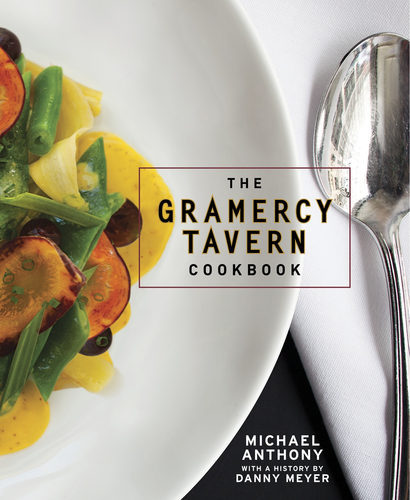Books |
The Gramercy Tavern Cookbook
Michael Anthony
By
Published: Feb 15, 2017
Category:
Food and Wine
A close friend and I gave a Valentine’s Day dinner for a VIP guest list: mostly old friends. I cooked a simple meal: braised beef, mashed potatoes, peas. The animating idea of a meal like that is to use quality ingredients in a recipe without tricks. This recipe couldn’t be simpler: brown the chunks of boneless beef chuck, sweat the carrots and onions, add tomato paste, beef stock and wine, and cook, covered, in the oven, for hours. Then mash and strain the vegetables, add to the sauce and reduce. Cost of beef: $60. $30 for other ingredients. So 9 had a terrific dinner for $90. A great meal for $10 a person? Yes. Using an easy-to-follow recipe? Yes. From the cookbook of one of the best restaurants in New York? Yes.
The year the Zagat guide rated Gramercy Tavern as New York’s second most popular restaurant — it’s now #9 — it noted that this is “about as perfect as a restaurant can get.”
Naturally I was interested in Gramercy Tavern’s first cookbook.
And of course I accepted an invitation from Michael Anthony, the restaurant’s executive chef-partner, for a small lunch for food writers in a private dining room.
The menu was Red Kuri Squash Soup with Brussels Sprouts and Apples; Cauliflower with Quinoa, Prunes and Peanuts; Porgy with Spaghetti Squash and Sherry Sauce; and, for dessert, Peanut Butter Semifreddo with Chocolate Macaroon and Hot Fudge.
There were flowers on the table, with small vegetables — artichokes, peppers and okra — placed among them so cleverly that it took me two courses to notice. The service was swift, silent, impeccable, which I expected; what surprised me was that one of the staffers clearing our plates was the restaurant’s managing partner.
Michael Anthony spoke briefly about the menu. The soup, he noted, was cooked in a single pot. The cauliflower was a separate course because he regarded vegetables as “shining stars.” Porgy, he noted, was “a simple, inexpensive fish.”
The idea, I gathered, was that these were dishes we could, using his cookbook, make at home.
With every blissful, three-star bite, I thought: Get real.
Michael Anthony is a boyish, unpretentious guy. On a quiz show, you’d never guess that in 2012 he won the James Beard Award for Best Chef in New York. His former employers in Paris include Jacques Cagna, Michel Guérard and L’Arpège. Before coming to Gramercy Tavern in 2006, he was executive chef of the celebrated Westchester restaurant, Blue Hill at Stone Barns.
Michael Anthony is nobody’s idea of a home cook.
I said as much to Dorothy Kalins, godmother to first tier cookbook writers and producer of the Gramercy Tavern book.
Her response: “I knew you’d say that.”
And she challenged me to cook a meal from the book.
This was a tougher assignment than I anticipated — once I opened the book, I could not put it down, for in addition to the recipes, there is a text as thrilling as, well, a thriller. Gramercy Tavern is a Danny Meyer restaurant, which means that it is really a brilliant play in which the characters just happen to create and serve astonishing meals. You don’t work here, you are cast. And to win your part, you need more than skills; personality and attitude are equally important. This is a team that assumes greatness as a baseline but aims much, much higher. It’s not a spiritual quest, but it’s close.
The book tells the history of the restaurant and profiles many of the people who work here. The stories inspire. Really, this book is a drug — it gets you high and makes you dream.
Yes, but can you cook from it?
I put myself to the ultimate test: I invited two friends for a dinner at which I’d serve an entrée I’d never cooked before: Braised Lamb Shoulder with Broccoli Puree. The text described how Michael Anthony and his team prepare it. The labor is daunting, even for a restaurant staff. Then comes a simplified version for the home cook. I eliminated the broccoli puree and set to work. But it wasn’t work. Braise meat. Chop vegetables. Cook in oven. Serve. [To buy ‘The Gramercy Tavern Cookbook’ from Amazon, click here. To buy the Kindle edition — but this is such a beautiful book, why would you want to read it on a screen? — click here.]
Our guests were two of our most sophisticated friends. She’s a queen in her field, and just as talented in the kitchen; when she comes to dinner, she arrives bearing gifts like homemade compote or a bottle of vodka she’s flavored with herbs from her garden. He’s a prolific, distinguished writer and broadcaster, a talker who makes Bono sound inept; in his presence, my conversation is limited to provocative questions.
Dear readers, these titans were stupefied.
“I can think of four houses in this country where I have eaten this well,” he said.
Here’s the recipe, without the puree. See for yourself.
Braised Lamb Shoulder
Serves 4
1 tablespoon olive oil
1 2-pound boneless lamb shoulder, tied or cut into large cubes
salt, pepper
1 onion, chopped
6 garlic cloves, minced
2 shallots, minced
1 carrot, chopped
1 celery stalk, chopped
½ tablespoon tomato paste
½ cup red wine
3 sprigs thyme
1 sprig rosemary
1 bay leaf
5 cups chicken broth or water
Preheat the oven to 325 degrees.
In a large, heavy, ovenproof pot with a lid, heat the olive oil over medium-high heat. Season the lamb with salt and pepper, add to the pot and brown well on all sides, about 15 minutes. Transfer the meat to a platter.
Reduce the heat to medium. Add garlic, onion, shallots, carrots and celery to the pot. Cook, stirring occasionally, until softened, about 6 minutes. Stir in the tomato paste and cook for a minute.
Add the wine and stir, scraping the bottom of the pot to loosen the browned bits. Simmer until the wine is almost gone. Patience! This is the magic moment for flavor.
Return the lamb to the pot along with its accumulated juices. Add the thyme, rosemary, bay leaf and enough broth to almost cover the meat. Bring to a simmer over high heat, cover the pot and transfer it to the oven.
Cook, turning once about halfway through, until the lamb is very tender, 2 to 2 and ½ hours. Transfer the meat to a cutting board.
Pass the liquid through a fine-mesh strainer into a wide saucepan, pushing down on the solids with a spoon to extract every last bit of juice. Bring the liquid to a simmer and reduce until it has thickened. You should have about a cup of sauce; this can take 30 minutes. Season with salt and pepper.
Serve the lamb shoulder whole or in pieces. Coat the meat with some of the reduced sauce and serve.
And swoon.


